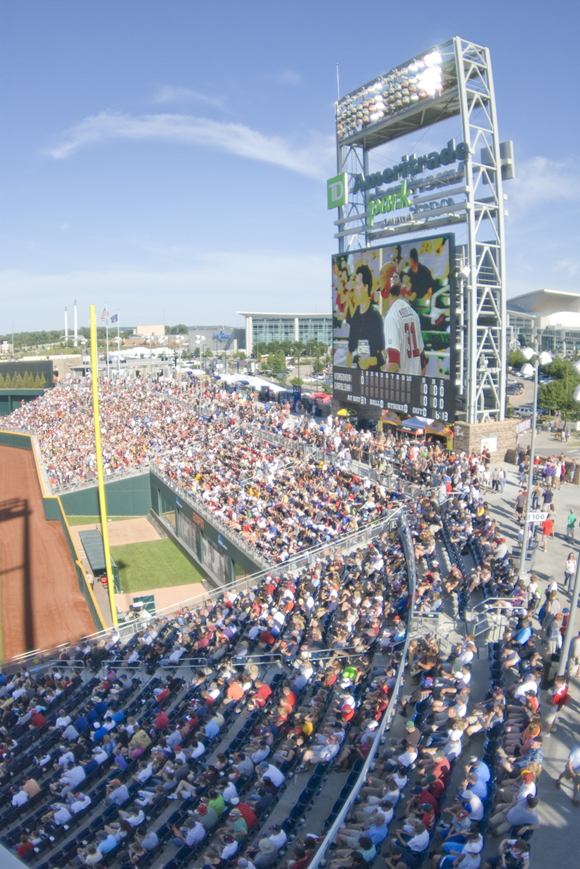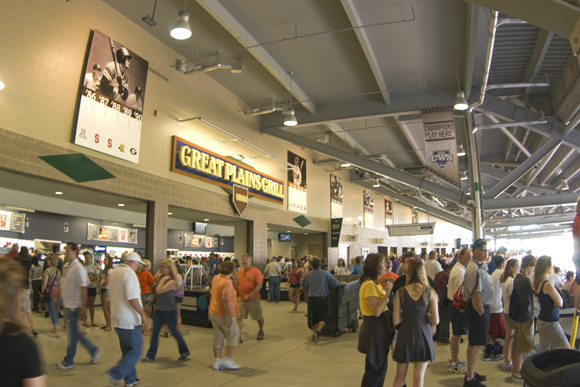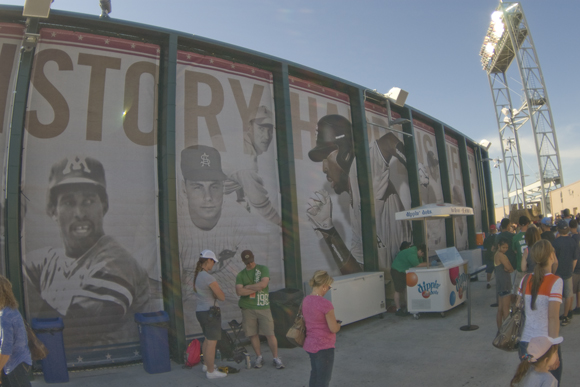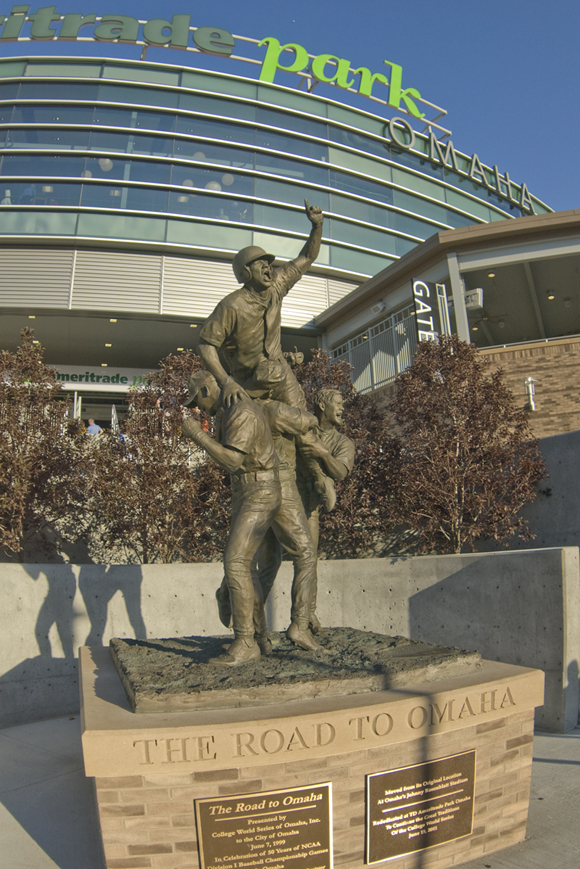Like many traditionalists, we were dismayed with Omaha officials announced plans to build a new downtown ballpark for the College World Series, abandoning Rosenblatt Stadium in the process. With TD Ameritrade Park now open and hosting a handful of CWS games, it’s easy to see the ballpark’s many strengths – and some high-profile weaknesses.
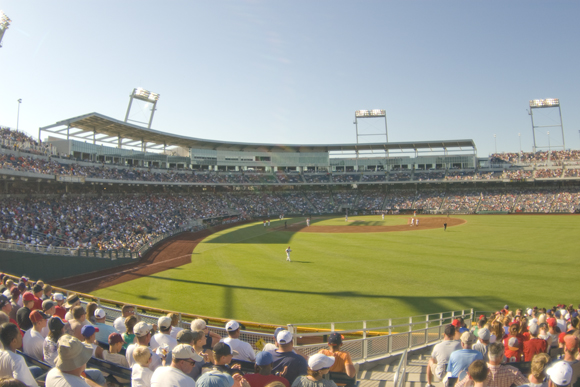
FAST FACTS
Capacity: 24,000 (includes club seating for 2,500)
Suites: 30
Architect: Populous, with HDR and DLR Group
Construction: Kiewit Building Group
Dimensions: 335L, 375LC, 408C, 375RC, 335R
Cost: $131 million
Owner: City of Omaha
Parking: Plenty of parking in the general area, as there are 9,000 spots within a 12-minute walk. We found most lots and ramps within a three-block walk of the ballpark cost $10 and $25, depending where you park. Surface parking prepurchased from the NCAA is $10. Reservations are required for the more enjoyable lots, like Lot B, where tailgating is encouraged.
Address: 1200 Mike Fahey St., Omaha. Chances are pretty good your GPS doesn’t recognize this address. You can use an alternative address of 455 North 10th Street, Omaha; this will put you within a block of the ballpark.
Directions: The ballpark is located next to Qwest Center in downtown Omaha and easily accessible via I-480, which runs east-west through town and is connected to I-80 and I-29.
(Click on an image to enlarge.)
We always enjoyed College World Series games at Rosenblatt Stadium: the 1948 ballpark was full of history and college-baseball lore, despite being a little run down and awkwardly configured to host both CWS games and Omaha Royals matches. Indeed, some of college baseball’s greatest feats – like Dave Winfield’s one-man mission to bring a title to the University of Minnesota in 1973, dominating both at the plate and on the mound – were recorded at Rosenblatt.
As the College World Series grew in popularity, though, Rosenblatt Stadium became a somewhat uncomfortable place to take in a sold-out game: the outfield bleachers were crowded and uncomfortable, seats down the lines were angled awkwardly, and concession stands in the grandstand were completely overwhelmed. Of course, if your team is in the Series, you’ll put up with all of that and more. If you’re just a general fan, you might not. Plus, as the NCAA began to rely on revenues generated by the CWS, there were limited opportunities to placate sponsors on game days.
So, ultimately, there were plenty of reasons for Omaha to consider a new ballpark, especially when other cities (like Orlando) made noises about building a new CWS ballpark and some MLB teams sniffed around in hopes of hosting the baseball classic. Rosenblatt’s future as the CWS home was clearly dated.
Flash forward to this month with the first College World Series games played at the new ballpark. Though Creighton University had played some regular-season games at TD Ameritrade Park, the first real test came with sellouts and near-sellouts for the CWS. We caught a sellout game, giving us plenty of time to see how the ballpark performed with a full house.
The result: it worked as planned, admirably so. But our biggest problem with the ballpark was with those plans.
For a ballpark seating 24,000, TD Ameritrade Park is surprisingly intimate. Though it’s closer in capacity to a PNC Park or Target Field, TD Ameritrade Park feels more like a larger minor-league park, like Raley Field or Coca-Cola Park. We wandered both down to seats behind the dugout and in the last row of the upper deck and found the view from the last row to be pretty good. There’s perhaps too much foul space across from each space; still, it’s a little deceiving because the backstop is only 52 feet from home plate, skewing the proportions. (In other words, the catcher is closer to the first row of fans than to the pitcher.) For a three-deck ballpark, the seat layout works, and it’s comfortable to boot: there are 36 inches between rows, an unusually generous amount of space for such a large ballpark. The capacity is an awkward design for a ballpark, but the architects pulled off a nice feat in making most seats have a good view of the action.
A wraparound concourse features views of the game from anywhere in the ballpark. It allows for a lot of milling around from fans with general-admission seats and who don’t feel like fighting for a bleacher seat. Despite some very wide concourses – between 32 and 33 feet wide in most instances – it gets crowded very quickly when there’s a sold-out game.
Really, though, we are writing about two ballparks. One ballpark is for the everyday fans, featuring comfortable seating (for the most part) and little else. The other ballpark, and the one most fans will never see, is for the NCAA, for the Omaha business elite, and for the sponsors. The suite/club level is its own world, with its own concessions, entrances and elevators. (We’d write more about this world, but the press was not allowed in.) It’s very easy to pony up for an expensive ticket and have little interaction with average fans. Similarly, the NCAA and its sponsors are cut off from the rest of the public.
A Tale of Two Ballparks
Make no mistake: the design of the ballpark was skewed to give these folks the best views. TD Ameritrade Park has one of the largest concourse overhangs that we’ve seen in recent years, especially in a smaller ballpark: the overhang was made necessary to bring the second-level suites and club seats closer to the action. Only the first 20 rows or so on the main level are clear of the overhand; anything in back of that may be great on a rainy day but a pain if you want to track the ball into the outfield or even see the scoreboard. (And don’t get us going about that scoreboard placement. A scoreboard directly down the right-field line isn’t convenient for many seatholders. We’re guessing it was constructed there so its backside could be a nice ad for the CWS and TD Ameritrade in downtown Omaha, as it’s located at the end of 12th Street.) High-def displays mounted on the overhang address the obstructed views of the scoreboard, but in terms of a view of the field you’re better off buying in either the first 20 rows off the concourse or down the first-base line on the second or even third level.
Now, there’s always been a separation of sorts at the College World Series: anyone attending CWS games at Rosenbatt Stadium remembers the segmented hospitality areas rising behind home plate and first base. However, the segmentation was limited because of the small Rosenblatt Stadium footprint. Here, the segmentation was built into the design from the ground up.
As of now, TD Ameritrade Park is a very generic facility. There are references to college-baseball history in the grandstand and at the entrances, but they’re limited to yearly winners and a very small handful of players. (We love Dave Winfield, but at least four versions of the same photo displayed in the ballpark and at an entrance seem a little redundant.) You won’t really learn anything about college baseball history at a TD Ameritrade Park.
In fact, the overall atmosphere is pretty bland. We understand why decoration was kept to a minimum – the emphasis is always on the game – but surely more can be done to liven up the grandstand concourse, playing bowl and exterior. Any displays of college-baseball history would be welcome; graphics with historic players could easily be added to the outfield wall. The College World Series is a celebration of college baseball, but there’s little of the celebratory spirit at the ballpark. Perhaps the most touching display, the Road to Omaha statue, isn’t original with the ballpark — it’s a holdover from Rosenblatt Stadium.
One thing done right: the party-like atmosphere in the parking lots was transplanted intact from Rosenblatt to TD Ameritrade Park. There are fans making the pilgrimage to the College World Series without setting foot in the ballpark or take in just a few games. For these fans, tailgating is the lure. Rosenblatt Stadium was surrounded by a sea of parking lots filled with tailgaters, and despite the urban location of TD Ameritrade Park, there’s still plenty of room for tailgaters, with spaces dedicated to them. In Lot B, just south of the ballpark, a shaded walkway running crossways through the lot is designed with specifically for tailgaters, with shaded areas for pitching a tent and appropriate support facilities – bins for hot coals, dumpsters and porta potties.
You may walk away from this story thinking we disliked TD Ameritrade Park. We didn’t. On the one hand, it’s successful on an architectural level: it does exactly what it’s supposed to do, and it manages to turn a 24,000-capacity ballpark into a improbably intimate venue doubling as a TV studio. (There’s even a microphone embedded in the pitching mound.) On the other hand, our issues are with what the ballpark is supposed to do, emphasizing the hoi-polloi experience (arguably) at the expense of the average fan. Some of those issues are simply inherent in the ballpark design, like the intrusive overhang, but others can be addressed as the College World Series settles into the new venue and generates some history of its own.
Concessions
Chicago’s Levy Restaurants is in charge of concessions. For the average fan, the concessions are barely ordinary, with a series of generic stands on the concourse offering generic food. The prices are OK – chicken tenders/fries cost $7.75, a double burger costs $8.50, — except that the lowest-priced hot dog was $3 (when you could find it) and a foot long was $8. More variety and offerings from local vendors is found in the outfield concourse, where you could find gyros and Mexican cuisine as well as barbecue offered by Famous Dave’s and a small local provider, Alexander’s. One nice touch: a gluten-free stand behind home plate. Of course, no beer is sold: your choices are between Pepsi products, lemonade and iced tea.
The better food offerings, it seems, were reserved to the club and suiteholders. At least that’s the way it looked through windows to the suite level: the press was specifically barred from walking through the club level. What was offered at the suite food stations looked a lot better than the dogs and pizza served to the general public.
Considering the food at Rosenblatt was above average, to see such generic offerings at TD Ameritrade Park for the masses is disappointing. Anyone attending a CWS game at Rosenblatt remembers those great burgers sold at the main gate, a promotion with Omaha stockmen. There’s simply no equivalent at TD Ameritrade Park, and maybe Levy can put a little more effort into grandstand concessions in 2012, but it looks like Zesto will have a new location next to TD Ameritrade Park by then.
Where to Sit
Best Seats in the House: The first five rows between the dugouts are simply great, as you’d expect. Because of the ballpark configuration, pretty much anything on the second level is outstanding: close to the field, angled toward the action, giving you a view of everything going on.
If you are forced to buy an SRO or GA ticket, be sure to get to the ballpark early and claim a spot at the bar rail in the concourse or past right field.
Seats to Avoid: The left-field bleachers. They’re OK during a day game, but an absolute sun field for an evening game. Also, avoid the back rows of anything in the main grandstand under the concourse; your views will be obstructed.
Before/After the Game
One thing the College World Series was designed to do: reward sponsors. And you’ll be subject to pitches from those sponsors around the ballpark, as tents are located on the south and southwest sides of the ballpark, containing offerings from various sponsors and vendors. So, depending where you come in, be prepared to walk the gauntlet as you approach the ballpark.
The College World Series may be dry, but the surrounding area is not. It’s not hard to find a drink within a block or two of the ballpark. These are not bars catering to oenophiles or beer snobs: they’re roadhouses with cheap Bud, loud music and TVs continually showing sports. They’re clustered south and northwest of the ballpark and pretty generic in nature.
The Old Market district is a short walk from the ballpark. It’s the psychic core of Omaha, featuring restaurants, shops, bars and more.
Where to Stay
It’s good to be a Hilton Honors member during the College World Series: there is a Hampton Inn and Homewood Suites directly northwest of the ballpark, as well as a higher-end Hilton a block south of the ballpark. Other hotels within a close walk include Fairfield Inn and Suites Omaha Downtown, Holiday Inn Downtown Omaha, DoubleTree by Hilton Hotel Omaha Downtown, Hilton Garden Inn Omaha Downtown/Old Market and Courtyard by Marriott Omaha Downtown.
—-
Share your news with the baseball community. Send it to us at editors@augustpublications.com.
Subscribers to the weekly Ballpark Digest newsletter see features before they’re posted to the site. You can sign up for a free subscription at the Newsletter Signup Page.
Join Ballpark Digest on Facebook and on Twitter!


